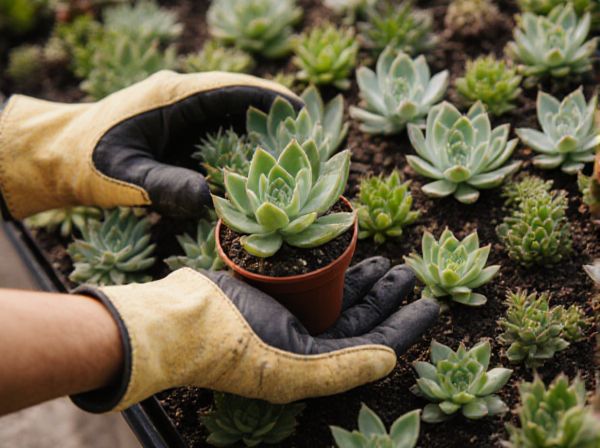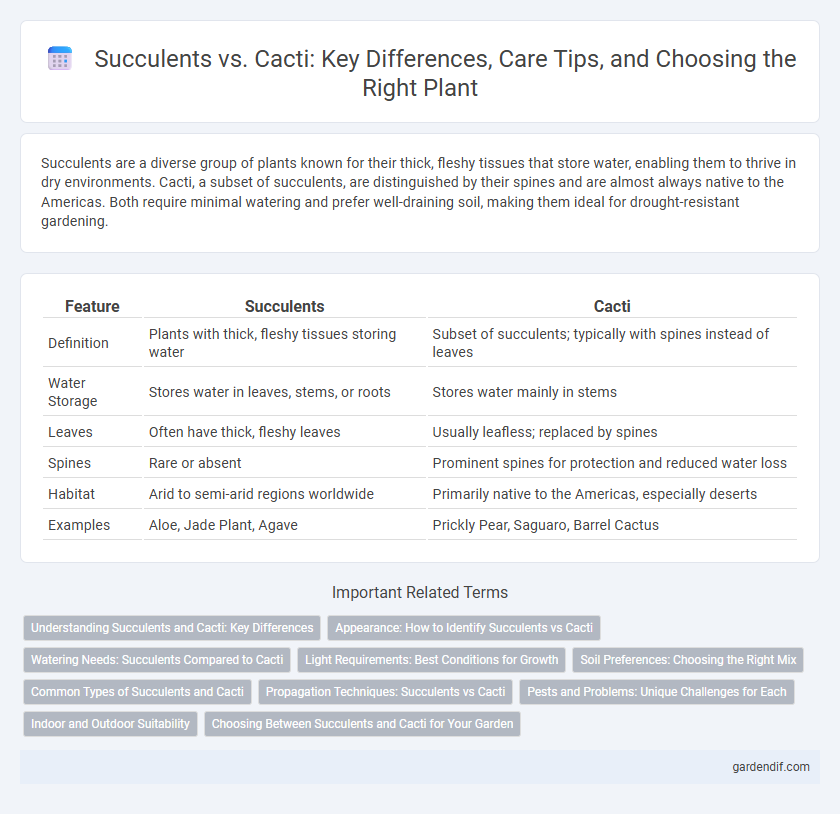
Succulents vs Cacti Illustration
Succulents are a diverse group of plants known for their thick, fleshy tissues that store water, enabling them to thrive in dry environments. Cacti, a subset of succulents, are distinguished by their spines and are almost always native to the Americas. Both require minimal watering and prefer well-draining soil, making them ideal for drought-resistant gardening.
Table of Comparison
| Feature | Succulents | Cacti |
|---|---|---|
| Definition | Plants with thick, fleshy tissues storing water | Subset of succulents; typically with spines instead of leaves |
| Water Storage | Stores water in leaves, stems, or roots | Stores water mainly in stems |
| Leaves | Often have thick, fleshy leaves | Usually leafless; replaced by spines |
| Spines | Rare or absent | Prominent spines for protection and reduced water loss |
| Habitat | Arid to semi-arid regions worldwide | Primarily native to the Americas, especially deserts |
| Examples | Aloe, Jade Plant, Agave | Prickly Pear, Saguaro, Barrel Cactus |
Understanding Succulents and Cacti: Key Differences
Succulents are plants with thick, fleshy tissues designed to store water, enabling survival in arid environments, while cacti are a subset of succulents distinguished by their areoles--small, cushion-like structures from which spines, branches, and flowers grow. Unlike most succulents, cacti typically have spines instead of leaves, which minimize water loss and provide protection. Understanding these botanical traits helps in proper identification and care of succulents and cacti in home gardening and landscaping.
Appearance: How to Identify Succulents vs Cacti
Succulents typically have thick, fleshy leaves or stems designed to store water, often featuring a smooth or waxy surface with a variety of shapes and colors. Cacti, a specific subset of succulents, are identified by the presence of areoles--small, cushion-like structures--where spines, flowers, or new branches grow; most cacti lack traditional leaves. Succulents can be distinguished from cacti by their leaf structure and absence of areoles, making features like spine presence and areole location key identifiers in plant classification.
Watering Needs: Succulents Compared to Cacti
Succulents typically require more frequent watering than cacti due to their higher moisture content and faster growth rates. Cacti possess specialized water-storage tissues and thick, waxy skins that enable them to survive extended drought periods, thus needing less frequent watering. Properly adjusting watering schedules to reflect these differences is essential for maintaining plant health and preventing root rot.
Light Requirements: Best Conditions for Growth
Succulents and cacti have distinct light requirements crucial for optimal growth. Succulents generally thrive in bright, indirect sunlight, requiring about 6 hours of filtered light daily to maintain vibrant colors and prevent leaf burn. Cacti prefer intense, direct sunlight for at least 6 to 8 hours per day, mimicking their native desert environments to promote healthy spines and blooming.
Soil Preferences: Choosing the Right Mix
Succulents thrive in well-draining soil blends rich in organic matter and minerals, typically containing components like peat moss, perlite, and vermiculite to retain moisture without waterlogging. Cacti require even grittier, faster-draining substrates with higher sand or gravel content to prevent root rot and mimic their native arid environments. Selecting the right soil mix promotes healthy root development and optimal water retention for each plant type's unique needs.
Common Types of Succulents and Cacti
Common types of succulents include Aloe Vera, Echeveria, and Jade Plant, known for their fleshy leaves and water-storing abilities. Popular cacti varieties comprise Saguaro, Prickly Pear, and Barrel Cactus, characterized by their spines and ribbed stems adapted to arid climates. Succulents generally have broad leaves while cacti feature areoles, the specialized structures from which spines and flowers grow.
Propagation Techniques: Succulents vs Cacti
Succulents propagate primarily through leaf cuttings and offsets, enabling rapid growth in diverse environments, while cacti rely on stem cuttings and grafting methods to ensure survival in arid conditions. Succulent leaf propagation benefits from high moisture retention in leaves, facilitating root development without soil disturbance, contrasting with cacti's requirement for dry calloused cuttings before rooting. Understanding these propagation differences optimizes growth strategies for both plant types in horticultural practices.
Pests and Problems: Unique Challenges for Each
Succulents often face issues with mealybugs and aphids, which thrive in their dense leaf structures, while cacti are more prone to scale insects and fungal infections due to their spiny stems and slower healing. Overwatering creates root rot in succulents, whereas cacti suffer from stem rot and sunburn when exposed to improper watering and excessive sunlight. Managing pests and diseases requires tailored approaches, such as insecticidal soap for succulents and fungicides combined with careful watering schedules for cacti.
Indoor and Outdoor Suitability
Succulents and cacti both thrive indoors and outdoors, but succulents generally adapt better to varying light conditions, making them ideal for indoor environments with indirect sunlight. Cacti prefer outdoor settings where they can receive full sun and well-drained soil, yet some varieties tolerate indoor spaces with bright, direct light. Understanding the specific species is crucial, as factors like humidity and temperature can influence their growth and suitability for interior or exterior planting.
Choosing Between Succulents and Cacti for Your Garden
Succulents offer a diverse range of shapes and colors, thriving in well-drained soil with minimal water, making them ideal for low-maintenance gardens. Cacti, belonging to the succulent family, feature spines and are specially adapted to arid environments, requiring even less water and more sunlight. When choosing between succulents and cacti, consider your garden's climate, sunlight availability, and watering routine to select the plant that best suits your care capacity and aesthetic preferences.
Succulents vs Cacti Infographic

 gardendif.com
gardendif.com